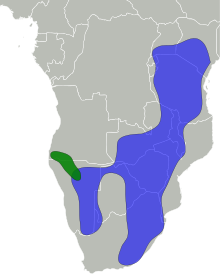
Back Rooibok Afrikaans إمبالة Arabic امباله ARZ Aepyceros melampus AST Импала AV Putcudol (Aepyceros melampus) AVK İmpalalar Azerbaijani Импала Bulgarian Impala Breton Impala Catalan
| Impala | |
|---|---|
| male | |

| |
| female with calf both in Kruger National Park, South Africa | |
| Scientific classification | |
| Domain: | Eukaryota |
| Kingdom: | Animalia |
| Phylum: | Chordata |
| Class: | Mammalia |
| Order: | Artiodactyla |
| Family: | Bovidae |
| Tribe: | Aepycerotini |
| Genus: | Aepyceros |
| Species: | A. melampus
|
| Binomial name | |
| Aepyceros melampus (Lichtenstein, 1812)
| |
| Subspecies | |
| |

| |
| Distribution:
Black-faced impala
Common impala | |
| Synonyms[2] | |
The impala or rooibok (Aepyceros melampus) is a medium-sized antelope found in eastern and southern Africa. The only extant member of the genus Aepyceros, and tribe Aepycerotini, it was first described to Europeans by German zoologist Hinrich Lichtenstein in 1812. Two subspecies are recognised—the grassland-dwelling common impala (sometimes referred to as the Kenyan impala), and the larger and darker black-faced impala, which lives in slightly more arid, scrubland environments. The impala reaches 70–92 cm (28–36 in) at the shoulder and weighs 40–76 kg (88–168 lb). It features a glossy, reddish brown coat. The male's slender, lyre-shaped horns are 45–92 cm (18–36 in) long.
Active mainly during the day, the impala may be gregarious or territorial depending upon the climate and geography. Three distinct social groups can be observed: the territorial males, bachelor herds and female herds. The impala is known for two characteristic leaps that constitute an anti-predator strategy. Browsers as well as grazers, impala feed on monocots, dicots, forbs, fruits and acacia pods (whenever available). An annual, three-week-long rut takes place toward the end of the wet season, typically in May. Rutting males fight over dominance, and the victorious male courts females in oestrus. Gestation lasts six to seven months, following which a single calf is born and immediately concealed in cover. Calves are suckled for four to six months; young males—forced out of the all-female groups—join bachelor herds, while females may stay back.
The impala is found in woodlands and sometimes on the interface (ecotone) between woodlands and savannahs; it inhabits places near water. While the black-faced impala is confined to southwestern Angola and Kaokoland in northwestern Namibia, the common impala is widespread across its range and has been reintroduced in Gabon and southern Africa. The International Union for Conservation of Nature (IUCN) classifies the impala as a species of least concern; the black-faced subspecies has been classified as a vulnerable species, with fewer than 1,000 individuals remaining in the wild as of 2008.
- ^ IUCN SSC Antelope Specialist Group (2016). "Aepyceros melampus". IUCN Red List of Threatened Species. 2016: e.T550A50180828. doi:10.2305/IUCN.UK.2016-2.RLTS.T550A50180828.en. Retrieved 12 November 2021.
- ^ Cite error: The named reference
MSW3was invoked but never defined (see the help page).
© MMXXIII Rich X Search. We shall prevail. All rights reserved. Rich X Search

